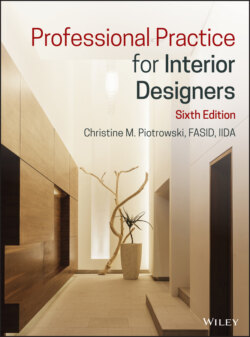Читать книгу Professional Practice for Interior Designers - Christine M. Piotrowski - Страница 17
DEFINING THE PROFESSION
ОглавлениеCompared to many other professions, such as teaching and medicine, interior design is relatively young. The use of the term interior design did not appear in general usage until after World War II, and the profession defined by any term did not really exist much before the 1900s. Individuals and organizations involved in the interior design profession work tirelessly to help the profession gain recognition in the minds of the public, as well as among practitioners and allied professionals.
What constitutes interior design has been debated and nurtured for many decades. Much of the public believes that “people who decorate interiors are interior decorators.” They often do not understand that there is a difference between decoration and design. The words of an article by Charlotte S. Jensen, FASID, then president of the National Council for Interior Design Qualification (NCIDQ) board, still ring true: “Interior design is not the same as decoration. … Decoration is the furnishing or adorning a space with fashionable or beautiful things. Decoration, although a valuable and important element of an interior, is not solely concerned with human interaction or human behavior. Interior design is all about human behavior and human interaction.”4 And much more, many would say.
The most commonly quoted and utilized definition of interior design comes from the Council for Interior Design Qualification (CIDQ). The abbreviated version of the definition from CIDQ is offered here. The complete version is presented in the appendix. The definitions are acknowledged and supported by the interior design professional associations:
“Interior design encompasses the analysis, planning, design, documentation, and management of interior non‐structural/non‐seismic construction and alteration projects in compliance with applicable building design and construction, fire, life‐safety, and energy codes, standards, regulations, and guidelines for the purpose of obtaining a building permit, as allowed by law. Qualified by means of education, experience, and examination, interior designers have a moral and ethical responsibility to protect consumers and occupants through the design of code‐compliant, accessible, and inclusive interior environments that address well‐being, while considering the complex physical, mental, and emotional needs of people.”5
Another excellent definition comes from outside the profession. According to the U.S. Department of Labor, Bureau of Labor Statistics, interior designers “plan, design and furnish interiors of residential, commercial or industrial buildings. Formulate design which is practical, aesthetic, and conducive to intended purposes, such as raising productivity, selling merchandise, or improving life style.”6
As you can see from these, interior design is much more than the stereotypical idea of picking out colors and fabrics. The responsibilities and skills required also go beyond those of the individual who has a flair for decorating.
